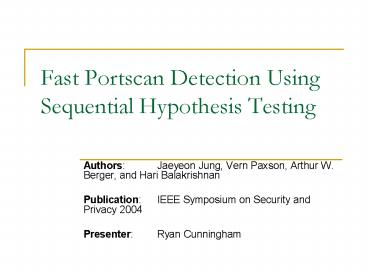Fast Portscan Detection Using Sequential Hypothesis Testing - PowerPoint PPT Presentation
Title:
Fast Portscan Detection Using Sequential Hypothesis Testing
Description:
Fast Portscan Detection Using Sequential Hypothesis Testing Authors: Jaeyeon Jung, Vern Paxson, Arthur W. Berger, and Hari Balakrishnan Publication: IEEE Symposium on ... – PowerPoint PPT presentation
Number of Views:112
Avg rating:3.0/5.0
Title: Fast Portscan Detection Using Sequential Hypothesis Testing
1
Fast Portscan Detection Using Sequential
Hypothesis Testing
- Authors Jaeyeon Jung, Vern Paxson, Arthur W.
Berger, and Hari Balakrishnan - Publication IEEE Symposium on Security and
Privacy 2004 - Presenter Ryan Cunningham
2
A quick note
- All images and equations taken directly from the
publication
3
Port scanning
- Network reconnaissance technique
- Usually a prelude to an attack
- Difficult to detect
- Traffic difficult to distinguish from regular
traffic - Stealth scans can occur very slowly
- Some scans are legitimate
- Search engine spiders
- SSH, peer-to-peer applications, etc.
4
Previous detection techniques
- Limit distinct connection attempts from one IP
- Network Security Monitor
- Snort
- Also detects malformed packets
- Limit failed connection attempts from one IP
- Bro
- Sensitive to service on specific port
- Robertson et al. showed threshold very important
5
Previous detection techniques
- Probabilistic model
- Developed by Leckie et al.
- Assesses typical traffic a machine receives
- Also assesses the traffic a remote machine is
likely to send - Combines these probabilities
- If the result is too much, an alert is sounded
- Generates too many false positives
6
Previous detection techniques
- SPICE
- Similar to probabilistic model
- Used to detect low traffic stealth scans
- Too computationally intensive for real world
7
Data set
- Traffic from two sites
- LBL
- 6,000 hosts
- Sparse address space 4.4
- ICSI
- 200 hosts
- Dense address space 42
8
Data set
- Anonymized TCP logs from Bro
- Recorded for one 24 hour period
- Bro NIDS flags for comparison and validation
9
Data set
- Unsuccessful Login attempt analysis
10
Data set
- Ratio of successful login attempts to
unsuccessful login attempt analysis
11
Observations
- Scans usually come from one host
- Scans make lots of failed connection attempts and
few successful connection attempts - Scans should ideally be detected quickly
- False positive rate should be configurable
12
Sequential Hypothesis Testing
- Proposed by Wald in the 1940s
- Method of doing repeated hypothesis testing as
sequential data is gathered - Deciding between two hypotheses
- Each time a data point arrives, decide
- Accept H0 (in our case, benign traffic)
- Accept H1 (in our case, port scan traffic)
- Wait for more data (next connection attempt)
13
Sequential Hypothesis Testing
- We specify parameters a and b
- a gt false positive rate
- b lt detection accuracy
- We must estimate parameters q0 and q1
- q0 probability a benign connection attempt is
successful - q1 probability a scanner connection attempt is
successful
14
Sequential Hypothesis Testing
- For each test, we compute the likelihood ratio
- Where
15
Sequential Hypothesis Testing
- Compare likelihood ratio to
- If
- L lt h0 then this is benign traffic
- L gt h1 then this is scan traffic
- Otherwise, wait for another connection
16
Sequential Hypothesis Testing
- We can estimate the expected number of
connections required to decide with
- Derivation is long and messy
17
Sequential Hypothesis Testing
18
Algorithm
19
Results
- Efficiency true positive / total reported
positive - Effectiveness true positive / total actually
positive
20
Results
- Comparison with Snort and Bro
- N bar average number of local hosts scanned
before decision is made
21
Contributions
- Extremely fast port scan detection algorithm
- High accuracy
- Low false positive rate
- Sound statistical foundation
- Soundly evaluate the weaknesses of their approach
- Good use of appendixes
- Cure for insomnia
22
Weaknesses
- Buffer of activity
- Attacker can spoof multiple IP addresses
- How is filled buffer dealt with?
- Flush buffer
- Attacker can use this to hide scan activity
- Maintain larger buffer
- Attacker can keep going until system crashes
- Distributed port scans undetectable
- Botnets are increasing in popularity
23
Weaknesses
- Test assumes independent connection attempts
- As suggested in paper, an attacker could exploit
knowledge of the system to connect to some
systems while doing surveillance on others - No real time testing conducted, only simulation
- Reasoning is a little circular
- Poor use of language
24
Improvements
- Implement and test in real time
- Perform suggested improvements in paper
- Differentiate between different services
- Differentiate between rejected and unanswered
connection attempts - Use a honeypot to see if complete three way hand
shake is completed (to detect spoofed IPs) - Should have kept some of the data away as a sort
of test data set

